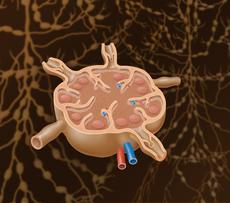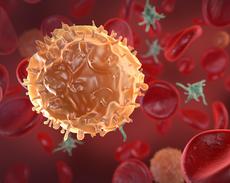Structure and function of the lymphatic system
Author: Maria Yiallouros, Editor: Maria Yiallouros, Last modification: 2024/02/03 https://kinderkrebsinfo.de/doi/e261504
Table of contents
The lymphatic system consists of all lymphatic vessels and lymphoid organs. For example, the lymph nodes, spleen, thymus gland as well as the lymphatic tissue found in the small intestine (Peyer`s patches) and throat (adenoid tonsils, palatine and tubal tonsils), to name a few, all represent lymphatic organs.
Hence, rather than representing a single organ, the lymphatic system comprises a circulatory network of vessels and lymphoid tissue and cells in every part of the body. It works together closely with the blood-producing (haematopoietic) system in the bone marrow, thereby playing a vital role in immune responses to protect the body from various pathogens. Also, the lymphatic vessel network helps transporting nutrients and waste products in the body.
Lymph and lymph vessels
The lymphatic system with its vessel network is – apart from the circulatory system, with which it is closely connected – the most important transport system in the human body.
The human body produces about two litres of lymph every day. This clear to yellow-tinted fluid is formed when blood plasma exits the capillary blood vessels and fillls the small spaces (interstices) between and around body tissues and cells before being collected through small lymphatic vessels (lymph capillaries).
Lymph transports nutrients and oxygen for the cells as well as immune cells (such as lymphocytes). While circulating through the interstitial spaces of various tissues, lymph also picks up many of the body’s waste products and carbon dioxide. Apart from that, lymph transports fat from the intestines to the blood. After having been collected by the lymph capillaries, lymph is transported through larger lymphatic vessels to the lymph nodes, where lymphocytes purge it before it is emptied into the large (subclavian) veins close to the heart, where it blends again with the blood.
Lymph nodes
The network of lymphatic vessels includes multiple interposed lymph nodes, small lentil- or bean-sized organs. They serve as filter stations for the lymph of a certain body region and contain specials cells of the immune system, the lymphocytes, which fight infections attacking the body. Hence, the lymph nodes clean the lymph and free it from pathogens and infectious bodies.
Spleen and thymus
The spleen is an organ in the left upper abdomen. Its job is to process old and damaged blood cells and microorganisms. Before birth, the spleen also helps producing blood cells. In early childhood, it plays a major role in building and maintaining the immune system.
The thymus is a gland located behind the breastbone (sternum). At birth, the thymus is the largest organ of the lymphatic system. It plays a vital role in building the immune system. The thymus gland is also considered as the „school“ of T lymphocytes („T“ as in „thymus“), because it teaches this subgroup of lymphocytes to differentiate between the body’s own and alien immune cells. This means that in the thymus gland the T lymphocytes learn and, thus, mature to be functional defence cells. The organ keeps growing until puberty. In adults, it loses its size and relevance and its lymphatic tissue is mostly replaced by fat cells.
Lymphocytes – the cells of the lymphatic system
The cells of the lymphatic system, the lymphocytes, are a subgroup of the white blood cells. They play a major role within the body’s immune defence, because they are able to target and eliminate pathogens. Lymphocytes are formed – like all other blood cells – in the bone marrow, where they arise from blood precursor cells, the so-called blood stem cells (haematopoietic stem cells) and mature in a stepwise process.
The immediate precursor cells of lymphocytes are the so-called lymphoblasts. While passing several developmental stages both in the bone marrow and in various lymphatic organs (for example lymph nodes, spleen, thymus gland), they change their shape and features. When their development is completed, the mature, thus functioning lymphocytes are ready to leave the bone marrow or lymphatic organs, respectively, in order to fulfill their chores in blood and tissues.
Depending on where their final maturation took place, lymphocytes are divided into two major groups: B lymphocytes and T lymphocytes. B lymphocytes mature in the bone marrow, while the maturation of T lymphocytes takes place in the thymus gland.
The mature T and B lymphocytes subsequently reach the downstream lymphatic organs, such as spleen, lymph nodes, or tonsils. Both groups of lymphocytes serve the body’s immune defence, however, with different functions.
Functions of lymphocytes
A major task of mature B lymphocytes, also known as plasma cells, is to produce antibodies [see antibody]. These are tiny protein molecules that stick to pathogens, thereby turning these into recognizable „enemies“ to be engulfed, digested, or killed by so called „guzzle cells“ (macrophages) or „natural killer cells“ (special T lymphocytes), respectively.
Natural killer cells are a subset of T lymphocytes able to recognize and subsequently eliminate virus-infested cells as well as cancer cells. Other T lymphocytes help the body to remember certain pathogens from previous contacts. These „memory cells“ basically organize the mission of the immune cells, thereby either activating or inhibiting the activity of the immune system.
The different subgroups of lymphocytes act in concert to fulfill their immunodefensive chores. They communicate via certain cellular messengers (hormones), the lymphokines. Taken together, the lymphatic system is a complex network of cells, tissues and regulatory mechanisms all working together to coordinate the body’s immune system.


